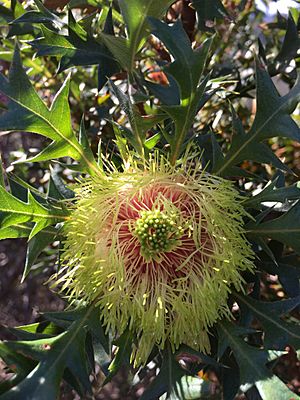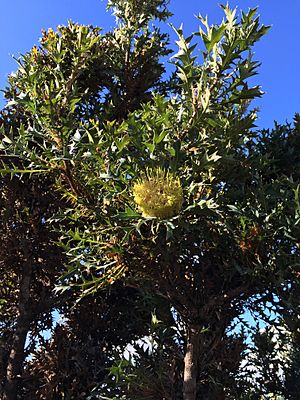Banksia hirta facts for kids
Quick facts for kids Banksia hirta |
|
|---|---|
 |
|
| Scientific classification | |
| Genus: |
Banksia
|
| Species: |
hirta
|
| Synonyms | |
|
Dryandra hirsuta A.S.George |
|

Banksia hirta is a special type of shrub. It grows only in Western Australia. This plant has fuzzy stems and leaves with deep, jagged edges. Its pale yellow flowers grow in clusters of about one hundred. After the flowers, it forms shiny seed pods. You can find this unique plant only in the Stirling Range National Park.
Contents
What it Looks Like
Banksia hirta is a shrub that usually grows up to 2 m (6 ft 7 in) tall. Its stems are covered in tiny hairs. This plant does not have a special woody base called a lignotuber. A lignotuber helps some plants regrow after a fire.
Leaves and Flowers
The leaves are shaped like a spear or a narrow egg. They are 50–130 mm (2.0–5.1 in) long and 15–35 mm (0.59–1.38 in) wide. Each leaf sits on a small stalk called a petiole, which is 5–12 mm (0.20–0.47 in) long. The edges of the leaves have five to ten sharp, triangular points on each side.
The flowers grow in heads, with about 90 to 110 flowers in each cluster. At the base of these flower heads are fuzzy, narrow leaf-like parts called involucral bracts. These bracts are 22–32 mm (0.87–1.26 in) long. Each flower has a pale yellow outer part, called a perianth, which is 40–41 mm (1.6–1.6 in) long. It also has a cream-coloured part for reproduction, called a pistil, which is 45–48 mm (1.8–1.9 in) long.
When it Blooms
Banksia hirta flowers from May to October. After flowering, it forms egg-shaped seed pods called follicles. These pods are 9–11 mm (0.35–0.43 in) long and look shiny. They have only a few hairs on them.
How it Got its Name
This banksia was first officially described in 1996. A scientist named Alex George gave it the name Dryandra hirsuta. He published his description in a science journal called Nuytsia. He found specimens of the plant in the Stirling Range National Park in 1986.
Why the Name Changed
The original name hirsuta is a Latin word. It means "having long, rather coarse hairs." This referred to the fuzzy stems, young leaves, and flower bracts.
In 2007, two other scientists, Austin Mast and Kevin Thiele, moved all Dryandra species into the Banksia group. However, the name Banksia hirsuta was already used for a different plant. So, Mast and Thiele changed the name to Banksia hirta. The word hirta is also Latin and has a similar meaning to hirsutus.
Where it Lives
Banksia hirta grows in rocky areas with shrubs and trees. You can find it in the central and western parts of the Stirling Range in Western Australia.
Protecting This Plant
The Government of Western Australia's Department of Parks and Wildlife has a special list for plants. Banksia hirta is on this list as "Priority Three." This means we don't know much about it, and it's found in only a few places. However, it is not currently in immediate danger of disappearing.

